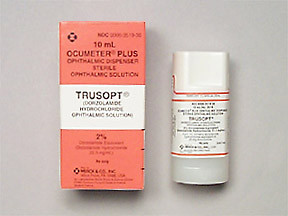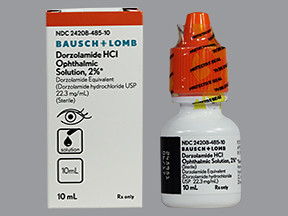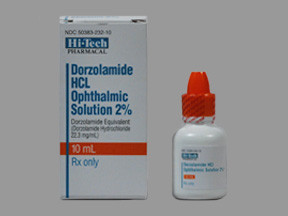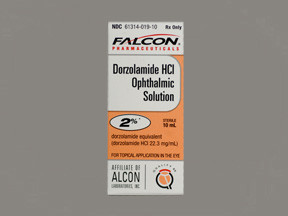DORZOLAMIDE SOLUTION - OPHTHALMIC
PHONETIC PRONUNCIATION: (door-ZOHL-uh-mide)
COMMON BRAND NAME(S): Trusopt
GENERIC NAME(S): dorzolamide HCl
Uses
USES: Dorzolamide is used to treat high pressure inside the eye due to glaucoma (open angle-type) or other eye diseases (e.g., ocular hypertension). Lowering high pressure inside the eye helps to prevent blindness. This medication works by decreasing the amount of fluid within the eye. It belongs to a class of drugs known as carbonic anhydrase inhibitors.
How to use DORZOLAMIDE SOLUTION - OPHTHALMIC
HOW TO USE: Read the Patient Information Leaflet provided by your pharmacist before you start using dorzolamide and each time you get a refill. If you have any questions regarding the information, consult your doctor or pharmacist. This medication is for use in the eye(s), usually one drop in the affected eye(s) 3 times a day, or as directed by your doctor. To apply eye drops, wash your hands first. To avoid contamination, do not touch the dropper tip or let it touch your eye or any other surface. The preservative that may be found in some products may be absorbed by contact lenses. If you wear contact lenses, remove them before using the eye drops with preservative. Wait at least 15 minutes after using this medication before putting in your contact lenses. Tilt your head back, look upward and pull down the lower eyelid to make a pouch. Hold the dropper directly over your eye and place one drop in your eye. Look downward and gently close your eyes for 1 to 2 minutes. Place one finger at the corner of your eye (near the nose) and apply gentle pressure. Try not to blink and do not rub your eye. This will prevent the medication from draining out. Repeat these steps for your other eye if so directed. Do not rinse the dropper. Replace the dropper cap after each use. If you are using another kind of eye medication (e.g., drops or ointments), wait at least 10 minutes before applying other medications. Use eye drops before eye ointments to allow the eye drops to enter the eye. Use this medication regularly in order to get the most benefit from it. To help you remember, use it at the same times each day. It is important to continue using dorzolamide even if you feel well. Most people with glaucoma or high pressure in the eyes do not feel sick.
Side Effects
Precautions
Interactions
Overdose
Images
Reviews
Faq for DORZOLAMIDE SOLUTION - OPHTHALMIC
Dorzolamide solution - ophthalmic is used to lower intraocular pressure in patients with open-angle glaucoma or ocular hypertension.
Dorzolamide solution - ophthalmic works by decreasing the production of fluid in the eye, thereby reducing intraocular pressure.
Common side effects of dorzolamide solution - ophthalmic include burning or stinging sensation in the eye, blurred vision, eye redness, and bitter or unusual taste in the mouth. Serious side effects are rare but may include eye pain, swelling, or discharge, sudden vision changes, and signs of an allergic reaction.
Dorzolamide solution - ophthalmic is typically used as directed by a doctor, which is usually one drop in the affected eye(s) three times a day. It is important to follow the instructions provided and not exceed the prescribed dosage.
It is recommended to consult with a healthcare professional before using dorzolamide solution - ophthalmic during pregnancy or breastfeeding, as it may pose certain risks to the unborn baby or nursing infant.
Dorzolamide solution - ophthalmic may be used in children, but the dosage and administration should be determined by a doctor.
The onset of action of dorzolamide solution - ophthalmic is usually within a few minutes to hours after administration. However, it may take several weeks for the full effects to be seen.
Dorzolamide solution - ophthalmic may interact with certain medications, such as oral carbonic anhydrase inhibitors or high-dose salicylates. It is important to inform your doctor about all the medications you are currently taking.
If you miss a dose, use it as soon as you remember. However, if it is almost time for the next dose, skip the missed dose and continue with the regular dosing schedule. Do not double the dose to make up for a missed one.
Disclaimer
IMPORTANT: HOW TO USE THIS INFORMATION: This is a summary and does NOT have all possible information about this product. This information does not assure that this product is safe, effective, or appropriate for you. This information is not individual medical advice and does not substitute for the advice of your health care professional. Always ask your health care professional for complete information about this product and your specific health needs.





No Reviews Yet